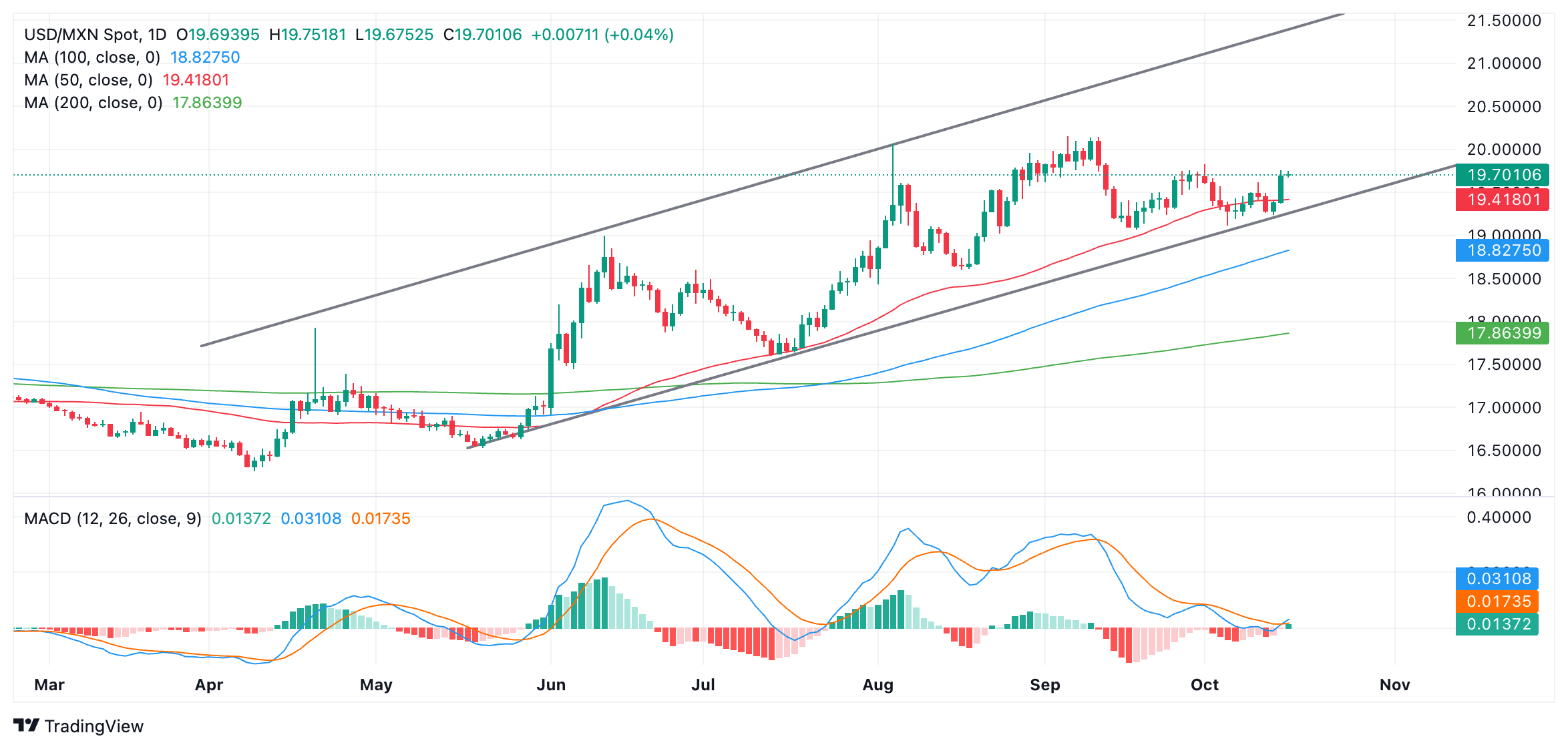- The Mexican Peso falls sharply after Donald Trump says he will stop the entry of cars made in Mexico into the US.
- A critical IMF report on Mexico’s economic prospects weighs even more.
- USD/MXN rises sharply from its support base at the base of an ascending channel.
The Mexican Peso (MXN) falls on Wednesday, continuing its depreciation from the previous day when it lost an average of 1.5% in its most traded peers.
The Peso sold off massively after former US President Donald Trump said he would impose tariffs of more than “100%, 200% or even 300%” on Mexican cars entering the US for prevent further erosion of the already weakened U.S. auto industry by foreign competitors. This, along with a critical report on Mexico’s economy from the International Monetary Fund (IMF), contributed to the sharp sell-off of the Peso.
The Mexican peso plummets after Trump’s interview
The Mexican Peso depreciated more than 1.60% against the US Dollar (USD) on Tuesday after Donald Trump threatened to impose prohibitive tariffs on cars made in Mexico entering the US market.
“Mexico is a tremendous challenge for us,” Trump said in an interview with John Micklethwait, the editor in chief of Bloomberg News, “China is building massive auto plants in Mexico. And they are going to make those cars and then take those cars and sell them on the border – they are very close to the border. And they are going to have all the advantages and none of the disadvantages. And that will be the end of Michigan, the end of South Carolina,” the former president said at the Economic Club of Chicago. .
Trump’s comments had even more impact because, according to bookmakers, he is now more likely to win the presidential election than Harris. According to OddsChecker, Trump has a nearly 58% chance of winning to Harris’ 42%.
That said, in the latest opinion polls, Vice President Kamala Harris continues to lead with 48.5% of the vote to Trump’s 46.1%, according to FiveThirtyEight.
The Mexican Peso affected by a damaging IMF report
The Mexican Peso was further weakened after the release of an IMF report on the country, which highlighted a slowdown in activity and growth.
“Activity is slowing. Despite an expansionary fiscal stance, growth is slowing to around 1.50% this year, partly due to capacity constraints and a restrictive monetary policy stance,” the report said. IMF, adding, “Risks to growth are tilted to the downside while inflation risks remain on the upside.”
That said, the IMF saw inflation falling steadily to the Bank of Mexico’s (Banxico) 3.0% target in 2025.
Downside risks to the outlook come from weaker-than-expected growth in the U.S., a rise in global risk aversion and “unforeseen effects of recent institutional reforms,” the IMF said.
On the positive side, the IMF highlighted the unique advantages of nearshoring Mexico given its proximity and the current free trade agreement with the US.
Regarding Mexico’s controversial new judicial reforms, which seek to have judges elected by popular vote rather than appointed, the IMF said these could “create significant uncertainties about the effectiveness of contract enforcement and the predictability of the state.” of law”, adding that they were “a new source of uncertainty that could affect private investment decisions”. Overall, however, the IMF was optimistic about the new laws, saying, “The current staff baseline does not incorporate potential headwinds from these uncertainties.”
Technical Analysis: USD/MXN shoots up from the base of the ascending channel
USD/MXN rises from a strong band of support at the base of an ascending channel and the 50-day SMA at 19.42.
USD/MXN Daily Chart

USD/MXN is probably now in a short-term uptrend, and given the technical analysis principle that “the trend is your friend”, this favors a continuation to the upside.
The next target is at 19.83 (October 1 high), and a break above that would likely lead to a move towards 20.10 and the vicinity of the September 10 high.
The Moving Average Convergence/Divergence (MACD) indicator (blue) has broken above its signal line (red), further indicating a bullish bias.
Banxico FAQs
The Bank of Mexico, also known as Banxico, is the country’s central bank. Its mission is to preserve the value of the Mexican currency, the Mexican Peso (MXN), and set monetary policy. To do this, its main objective is to maintain low and stable inflation within target levels – at or near its target of 3%, the midpoint of a tolerance band between 2% and 4%.
Banxico’s main tool to guide monetary policy is the setting of interest rates. When inflation is above the target, the bank will try to control it by raising rates, which makes borrowing more expensive for households and businesses and therefore cools the economy. Higher interest rates are generally positive for the Mexican Peso (MXN) as they lead to higher yields, making the country a more attractive place for investors. On the contrary, lower interest rates tend to weaken the MXN. The rate differential with the Dollar, or the way Banxico is expected to set interest rates compared to the United States Federal Reserve (Fed), is a key factor.
Banxico meets eight times a year and its monetary policy is greatly influenced by the decisions of the United States Federal Reserve (Fed). For this reason, the central bank’s decision-making committee usually meets a week after the Fed. In this way, Banxico reacts and sometimes anticipates the monetary policy measures set by the Federal Reserve. For example, after the Covid-19 pandemic, before the Fed raised rates, Banxico did so first in an attempt to decrease the chances of a substantial depreciation of the Mexican Peso (MXN) and avoid capital outflows that could destabilize to the country.
Source: Fx Street
I am Joshua Winder, a senior-level journalist and editor at World Stock Market. I specialize in covering news related to the stock market and economic trends. With more than 8 years of experience in this field, I have become an expert in financial reporting.







